22-28 January 2013. We found a tour company offering day trips to Phou Khao Khouay National Park for $160 each. So we walked into a travel agent chosen at random, by good luck or by good intuition, (I sometimes wonder if there is a difference) and organized our own guide for less than half the price. We were lucky beyond measure once again. It was just the two of us with a wonderful French man called Albin, who had been living and working in Laos up north in Luang Prabang. I can’t now remember why he’d come to Vientiane. He’s a botanist with a specialty in ferns, and an enormous knowledge of the Lao bush. When we got to the park, an hour or so outside Vientiane, we were joined by two Lao men, one of whom was an official park guide and required by law to be with us.
I think the park guide was a shaman, and the other his apprentice. And Albin wasn’t too shabby either. We hiked and hiked and hiked for hours, stopping frequently as one or other of them would suddenly duck behind a tree, or step off to one side, and point out something of interest. How did they know how to find them? Orchids orchids orchids. Never have I seen so many wild orchids, and so many varieties. We would not have seen any of them if we’d been alone. They are frequently very small, and shy, and even the bigger one was not directly on the path but hidden in the bush. Our guides were magic, all three of them.




The most magnificent of all was found right near the end of our hike.

We lunched here:

and ate this:

We had no idea, but the park guides had been carrying this entire lunch for the five of us in their packs. Front left is egg, front right is pork, behind the pork is stir-fried vegetables, and next to them some horrendously spicy stuff we didn’t go near. It’s all repeated behind, and there are also four baskets of sticky rice. It was all very good. It was a very typical Lao meal. Well partly . . . . . . . .
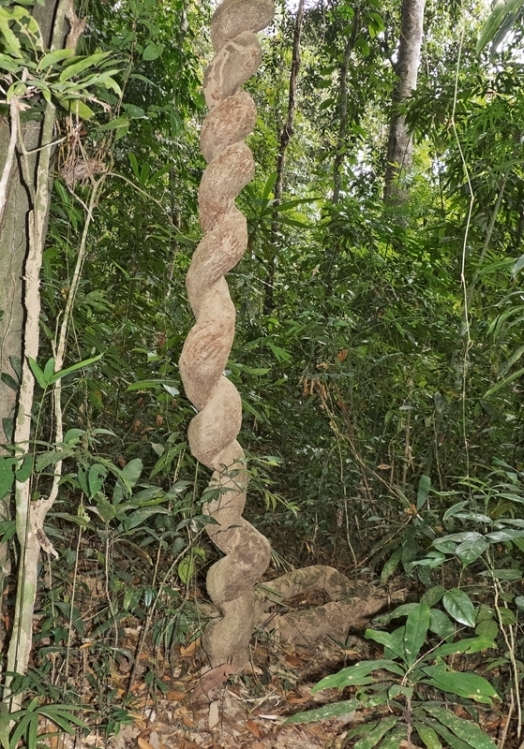
These are little creatures. Initially there were many of them all clumped together and we thought it was a puffball, or flower, or lichen or something. Then Albin just gently touched it with a little twig and they started jumping all over the place. Aren’t they extraordinary?
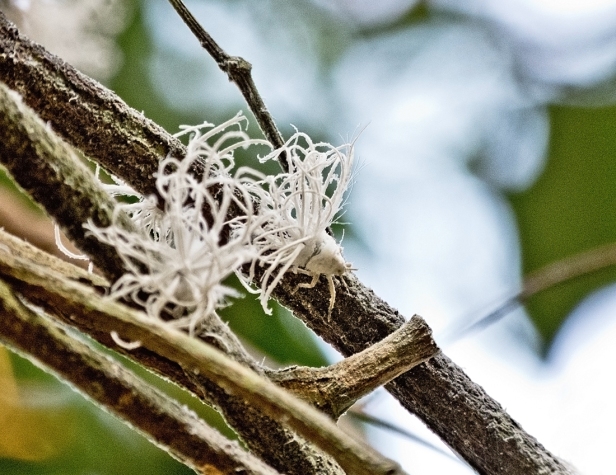

Buntiang, our fabulous Lao guide

Another day, another excursion. This time we visited a Hmong village. I was remembering the Hmong from up north in Vietnam in and around Sapa, where they still live a traditional, if tough, subsistence life, mainly growing rice, and maintaining their traditional ways, and dress. It is not put on for the tourists, but is simply how they live, though some of them do supplement their income selling their handicrafts and hiking tours to tourists. There are some photos in this post: https://alisonanddon.wordpress.com/2010/05/11/west-australia-vietnam/
It’s not like that in Laos, at least not near Vientiane. Later on, in Luang Prabang, we were told that if we wanted to see tribal life still practiced in the old ways we’d have to go far north in Laos, just as we did in Vietnam. Most people who live in the village we visited near Vientiane live in homes with woven bamboo walls and thatch roofs, though a few, presumably wealthier people have regular homes. Pretty much everyone has a satellite dish, and probably a cell phone too, plus a tractor and/or a motorbike.

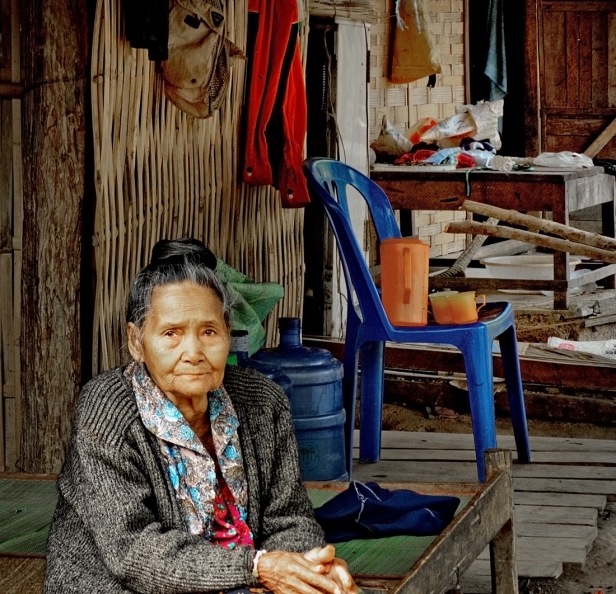

We visited the Ban Keun salt works. Saline water is pumped from underground, boiled, steamed, and then spread out to dry. It’s incredibly hot and steamy work for very little money. The children that greeted us were an apparently happy bunch of ragamuffins, the adults probably not so much. The whole enterprise was fascinating.
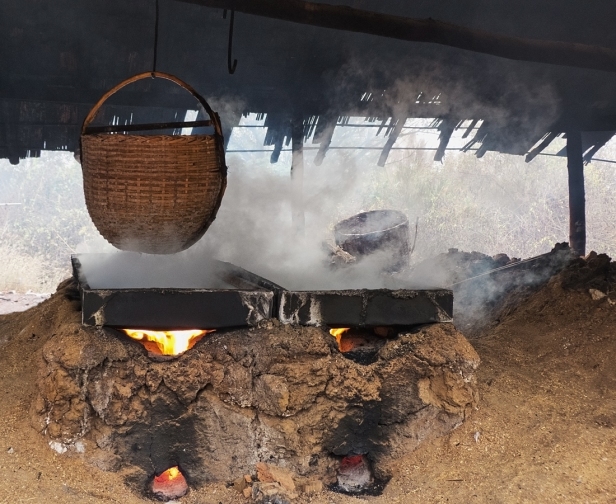



A short way out of Vientiane we visited two markets, one large and under cover, the other at the side of the road. Both markets had a plentiful supply of fruits, vegetables, fish and chicken for sale. Albin told us that there’s very little wildlife in Laos because it is all hunted for food even though it’s illegal to do so. Laos is one of the poorest countries in the world. Add to that the fact that the USA, in secret, dropped one hundred bombs on Laos, every eight minutes, day and night for nine years, from 1964 to 1973. A hundred bombs. Every eight minutes. For nine years. It’s barely comprehensible. Because of that, much land that could be farmed is unsafe. The Lao, like human beings everywhere, do what they need to do to survive. So they also eat insects, rats, bats, native birds, and many things people in richer countries find utterly stomach-churning. We do too – find it stomach-churning, if completely understandable. If you’re raised eating roast insects, grubs, and any kind of meat that’s available you presumably think little of it as an adult. In the big market two different vendors each quickly covered a large furred animal, about cat-size but not cats, when they saw our cameras coming. The people at the roadside market appeared to have no such qualms even though they seemed to be selling similar animals.
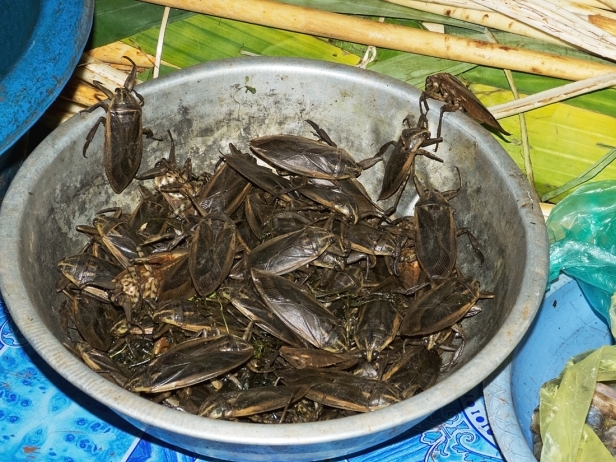



Geckos and stilettos
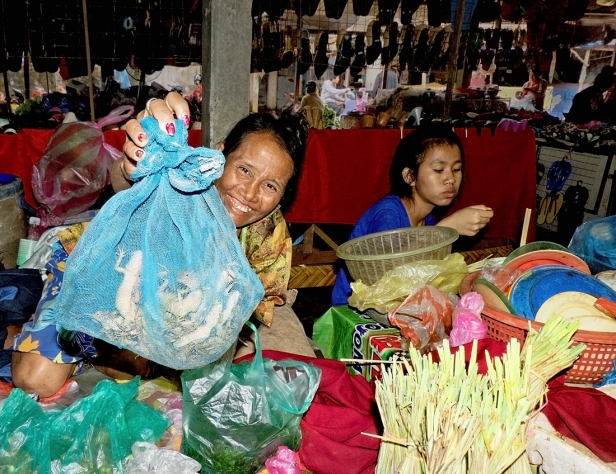
Negotiating the price

Dozens of little birds

Even the colourful native birds are not spared
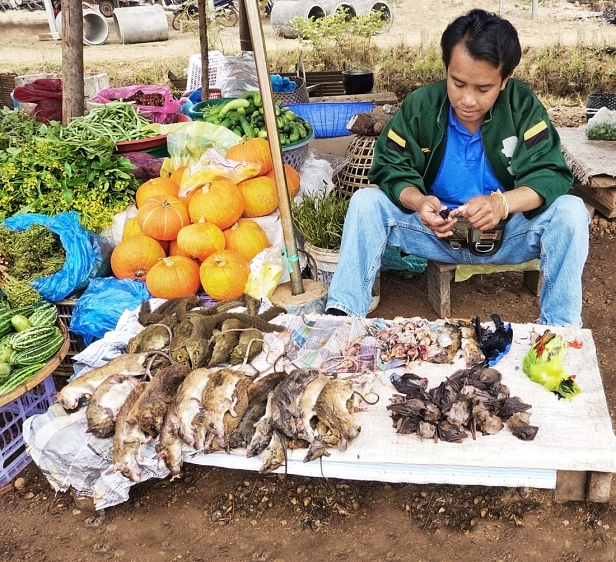
The whole experience was eye-opening to say the least, and, yes, fascinating. I could see that what was so exotic, and disturbing, for us was just plain normal for them. All the people we saw, both selling and buying, were just ordinary folk living their lives the best they know how.
Well didn’t this post start off real pretty and end up all gruesome!
Next post: From Vientiane we travelled by minivan to Vang Vieng, a journey that had me shrieking at the driver, and from Vang Vieng by bus to Luang Prabang.
All words and images by Alison Louise Armstrong unless otherwise noted.
© Alison Louise Armstrong and Adventures in Wonderland – a pilgrimage of the heart, 2010-2015.


I like the adjectives you chose for the last few food photos…. I have some different ones, but ’nuff said.
Beautiful orchids indeed!
LikeLike
stomach-churning not descriptive enough for you?
Yes, the orchids were a complete delight.
LikeLike
Aside from the gut-churning bats, etc. this is a great post and how luck with the guides. That was quite a meal they carried for ya’ll. Beautiful photos. How wonderful you saw all this and captured it on film. Really enjoyed being a fly on the wall for this one. Thank you.
LikeLike
Thanks Paulette. Yes gut-churning. Quite shocking at the time really. Don had to walk away. He’s more squeamish than me 🙂 I was fine as long as I didn’t think about actually eating any of it.
The national park was absolutely beautiful. Such a contrast.
LikeLike
I think I would have run screaming from those bugs 🙂
LikeLike
Don did 🙂
Well not actually screaming lol, but he certainly stayed away.
I’m fine with bugs as long as I don’t get one on me – then I’d be screaming!
LikeLike
ha ha yes about pretty – gruesome!
I was going to write how beautiful til I kept reading…fascinating though, thank you.
LikeLike
Well the first part was beautiful 🙂
It’s the reality of life in a poor country – I don’t think I’d been quite so confronted by it before.
LikeLike
Wonderful post. Natures absolutely beautiful. My favorite orchid is the fourth one down. I like the red stripes on the petals and in the flower. 🙂 The twisted tree trunk and white creatures are amazing and unique. You’re correct if a child who grew up eating rats, birds and insects you wouldn’t think anything of it. We do what we learn, know and seems normal…just like behaviors and beliefs. 🙂 Thank you Alison, Pam
LikeLike
Thanks Pam. Yes, our day in the national park was lovely. I was astounded by all the orchids – so many varieties. I have to say my fave is the big purple one. I like its grandiosity! And that it grew in the wild!
Whatever our feelings re the foods available in the market, at the time, right there, it was clear that this was all very normal for the Lao people; just part of daily life.
LikeLike
Lovely story to read, many things we didn’t see when we were there!
LikeLike
Thanks Cora. We saw things we didn’t expect to see, that’s for sure.
LikeLike
Alison,
A beautiful post–I mean that in so many ways. Your end section makes me think who are the real barbarians-those that eat bugs, rats, and bats, or those that covertly bombed a country for 9 years? Thank you for sharing so many perspectives of life, travel, and humanity. {{{Hugs}}} Kozo
LikeLike
Ah yes, Kozo, I think we know who the real barbarians are. I can’t wrap my mind around it – that there are actually human beings who exist who think that that would be an okay thing to do, that there are human beings who exist who gave the orders to do that. It’s completely mind-boggling to me. The scale of it alone is incomprehensible.
I must say it never occurred to me that the Lao are barbarians, though it may well occur to some people, and of course I do get your point
(((((Hugs)))))
Alison
LikeLike
That’s about the only thing that would send me down the vegetarian path.
LikeLike
Yeah, me too I think, though I’ve been semi vegetarian for years so it wouldn’t be too much of a stretch.
Most of those um . . .exotic foods are completely gag-worthy to us, but not to them apparently.
LikeLike
Oh my…. Gorgeous pictures! And I just love those beautiful little fluffy creatures. What an adventure. But the food – if I weren’t already vegetarian…
LikeLike
Thank you! Aren’t those little fluffy things great?! We saw them in Myanmar too. Very cute, but, um, yes, the food – not so much. Still people all over the world eat things that they’re raised on and think is normal, that we would never touch. So I guess we all just have our own “normal”.
LikeLike
That’s true – in Denmark there’s this thing called ‘liver paté’ and it’s very popular. It’s a variation of foie gras just made from pigs liver. Also the Swedish ‘pickled heering’ is sort of weird.. I could imagine both to be quite yucky in the eyes of some people 🙂
LikeLike
Oy pickled heering, tried that. Once 🙂
Also I was thinking of sheep/goat eyeballs (cringe) – aren’t they a delicacy somewhere in the world?
We’re mainly vegetarian. Eat seafood/fish but avoid meat except chicken.
LikeLike
ALISON: 90, 90 for 9 – that’s what we’re calling our upcoming Southeast Asia trip – 90% humidity, at 90 degrees for nine weeks. 21 October, my husband (60) and I (55) start backpacking through Thailand, Laos, Cambodia, and Malaysia. We are nature loving, non-partiers with limited resources. With relatively good health, and only a few manageable medical issues, it’s seize the day for tomorrow may never come. I have a few SEA questions: (1) How can we reach Albin, your guide for Khao Khouay National Park? (2) Is fresh juice okay in SEA (you said you never ate anything raw)? My biggest worry about SEA is getting sick from food and drink. I’d done my research due diligence, but ANY additional suggestions would be appreciated. (3) If we go to Vang Vieng, we’ll have to go to Vientiane for the flight to Siem Reap (rather than from Laung Prabang). Is Vang Vieng worth going to Vientiane? (4) Would Ross Green, Music Seeds International, have any interest in visitors? I’m gulping up your blog in huge swallows as we drive away from Grand Rapids, Michigan 2 October – we’ve just sold/given away everything but 8 suitcases and four boxes. May have a few more questions. Oh, and I’m the idiot that can’t spell your name right in the La Manzanilla post. Take Care, Lee
LikeLike
Hi Lee,
Don here again. You’re right about the 90,90 in Southeast Asia: just be prepared to feel slightly damp all the time. The contact information for Albin Duzer in Vientiane is ali.kruger@gmail.com. His phone number is 8562023899799. It is possible, however, that he’s no longer living in Vientiane, and neither Ali nor I can remember the name of the travel agency where he worked, but if you email him he should be able to tell you the name of the company. We went to another company called Green Discovery, but their tours were very expensive. Green Discovery is on the main road in Vientiane. We choked at their prices, and found by serendipity a tour/travel company on one of the smaller side streets who connected us with Albin.
We never did fresh juice while we were out and about because the knives that are used to cut the fruit can pick up contaminants from the skin of the fruit. Whenever possible we bought our own fruit and then soaked it for 20 minutes in a mixture of the local tap water and 5-10 drops of grapefruit seed extract, which you can get at your local health food store in North America. We never got sick when we did that. Drink only bottled water, don’t eat salads in restaurants and make sure that anything you eat in a restaurant is hot and has been freshly cooked. We still got sick from time to time from eating or drinking something, and then we took a broad-spectrum antibiotic called Azithromycin, which you can get on prescription from your family doctor or a travel medical clinic before you leave.
It’s a long bus ride from Vientiane to Vang Vieng and then another long bus ride to Luang Prabang. If you have to miss anywhere, miss Vientiane. Vang Vieng is stunning and a good place to stop for a few days on the way to Luang Prabang. We stayed in a lovely hotel right by the river and overlooking some stunning cliffs on the other side of the river. We’d planned to stay just one week in Luang Prabang but loved it so much that we stayed an extra week. We then flew from Luang Prabang to Chang Mai.
We don’t know where Ross Green is right now, but it’s possible he’s at home in Canada. He was in India, but I don’t think he’s there at the moment. I’ll ask him on FB and let you know.
Good luck with the rest of your travel plans. Carpe diem (Seize the day) is one of our favourite expressions too. Feel free to pick our brains for more information any time you want.
Regards,
Don
LikeLike
I’m so impressed that you’ve sold everything but a few essentials. That’s so exciting! A huge journey awaits before you.
LikeLike
Don and Alison: My email to Albin came back failed – oh well. I’m so glad you alerted me to issues with fresh juice. I knew not to eat salads and other fresh vegetables; however, I had not considered utensil and cutting board contamination. I’ve started researching grapefruit seed extract as well as Lugol’s Iodine Veggie Wash. This research uncovered data that says carbonated bottled water is better than regular bottled water because the water source for the bottled water may be contaminated and carbonation increases the acid in the water which kills the bacteria. I’ve had Traveler’s D before and expect to have it again; however, because of the length of our trip I want to be smarter. I also found Green Discovery – looked good but too expensive for us too. We plan to stay in Laung Prabang 5-7 days. Our plan has us moving a bit slower than your itinerary. Once we are on the ground, my GO-GO CAN’T SIT STILL husband may move us to do more and faster, but that 90, 90 will likely slow him down. Take care, Lee
LikeLike
We ended up choosing 12 days in LP and cut our time in Chiang Mai short, though 5 days is enough to cover the top things to do and see there. Vang Vieng is definitely worth it. We wished we’d had more time there.
Take antiseptic hand wipes (or gel) with you and use it often.
Have a great time! So excited for you. Keep in touch!
Alison
LikeLike
I, too, am always impressed by some people’s knowledge on wild animals and plants. It’s really cool to be able to call each plant with its own name, instead of trees and shrubs. 🙂 Such a wonderful hike, Alison, and your visit to the Hmong village was indeed eye-opening.
LikeLike
That was a great hike. We did day hikes in every place we went to in SE Asia and each one was a really rich experience. I think we were just plain lucky to get Albin and Buntiang as our guides.
As for the Markets – fascinating, and yes eye-opening. To me it’s incomprehensible and completely incorrigible what the US did to that poor little country for barely any reason at all (their excuse was that the Vietcong were using Laos as a route to get to South Vietnam). I’m not remotely surprised that their diet has become what it has. I’ve read of a new fast method of clearing land mines (using dogs) that is being used in Africa. Hopefully it will spread to Laos for bombs soon so that they can more quickly reclaim their land.
Alison
LikeLike
That reminds me of a TV program on the Ho Chi Minh trail that I watched a few weeks ago. Local people recounted the days when bombs were dropped every day, and mountains were destroyed. Such a horrendous event it really was.
LikeLike